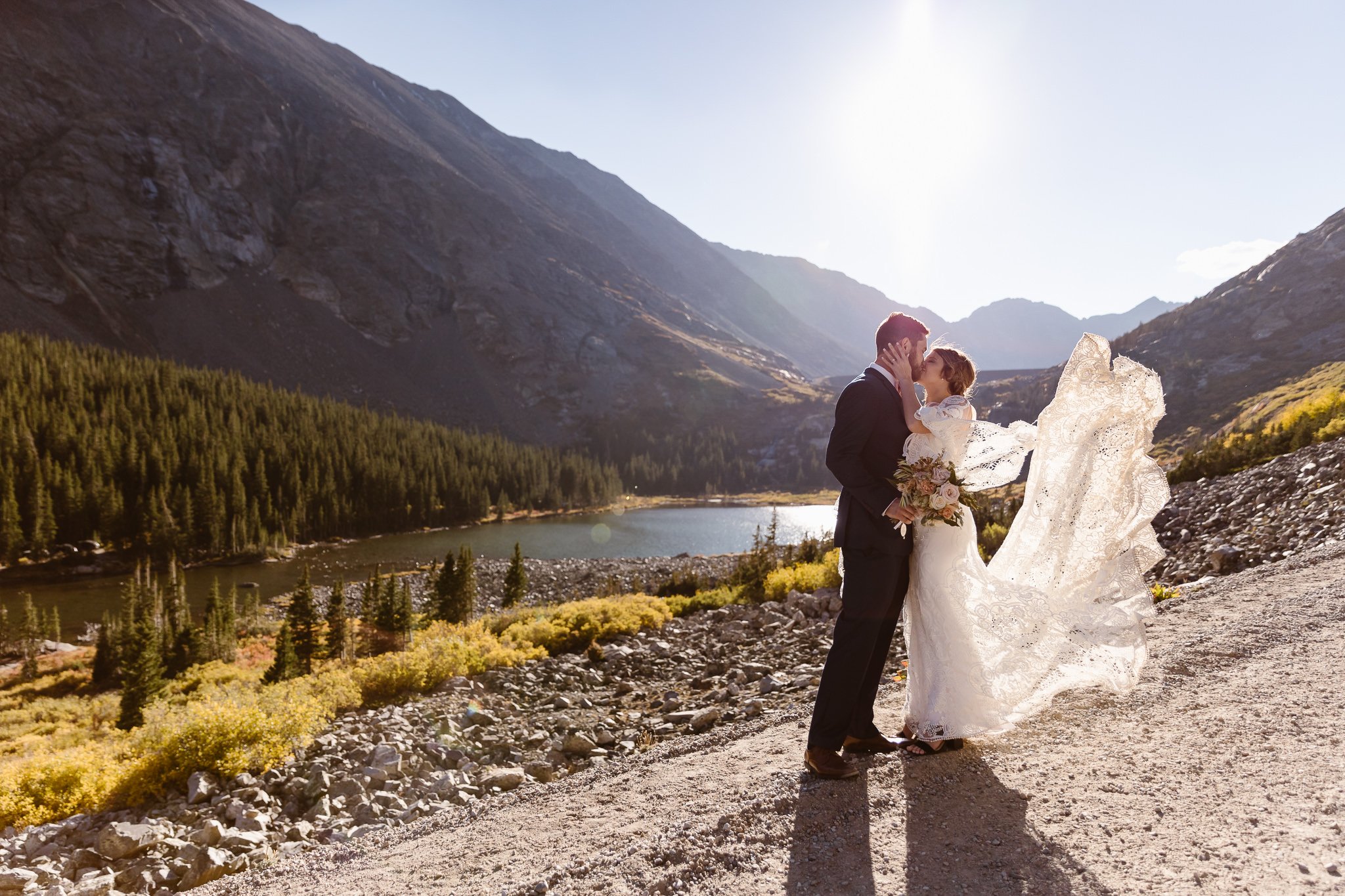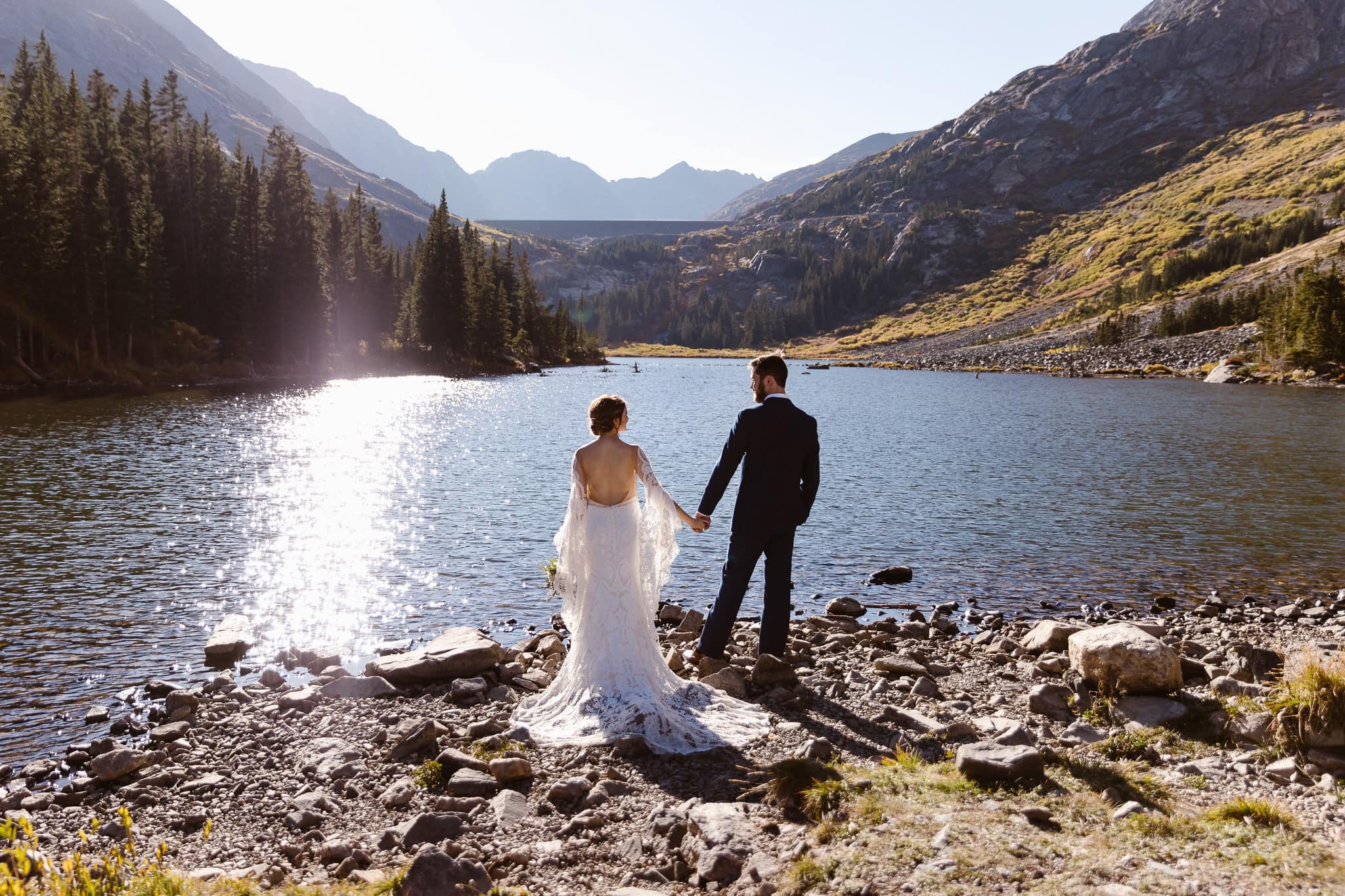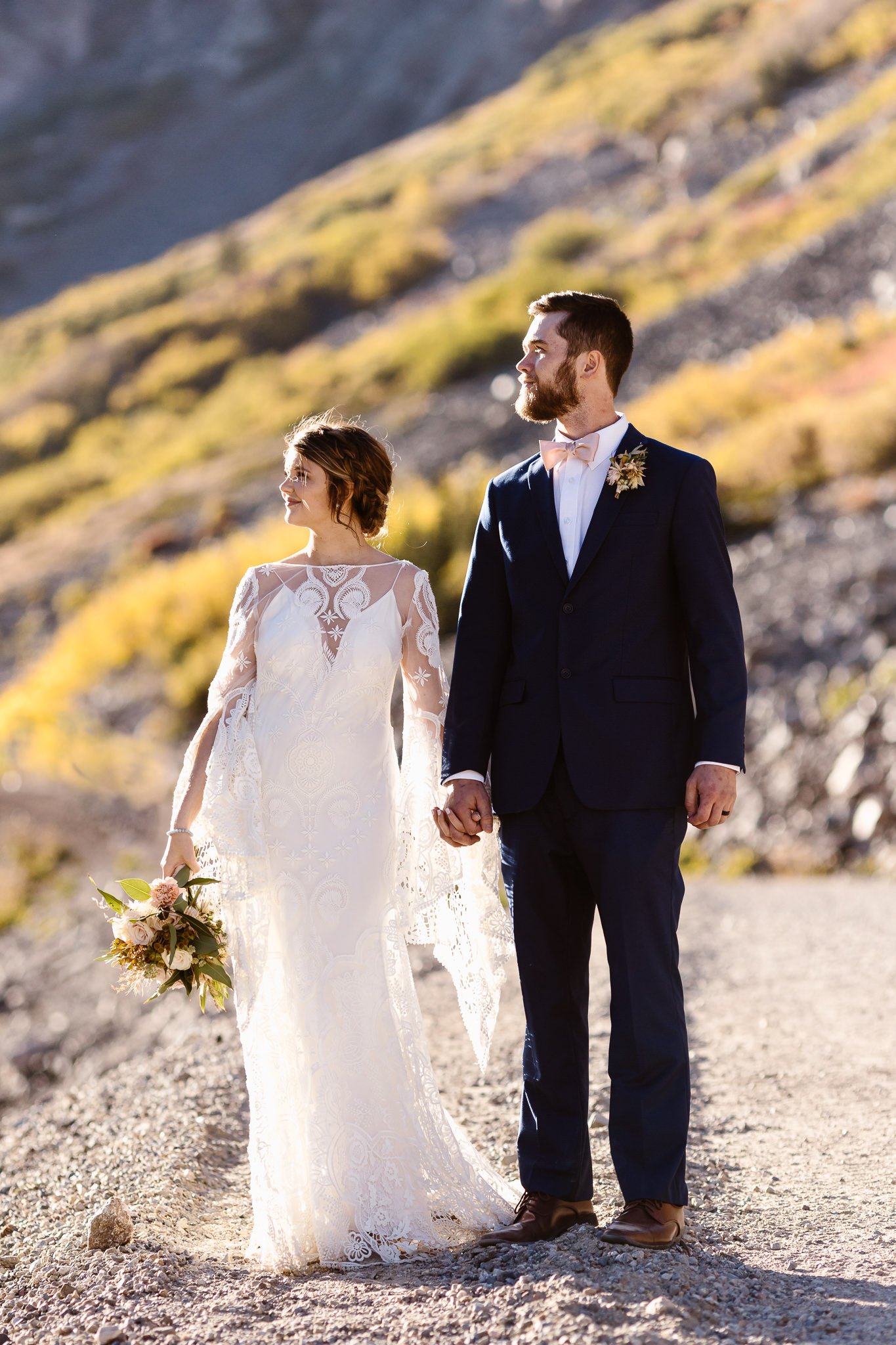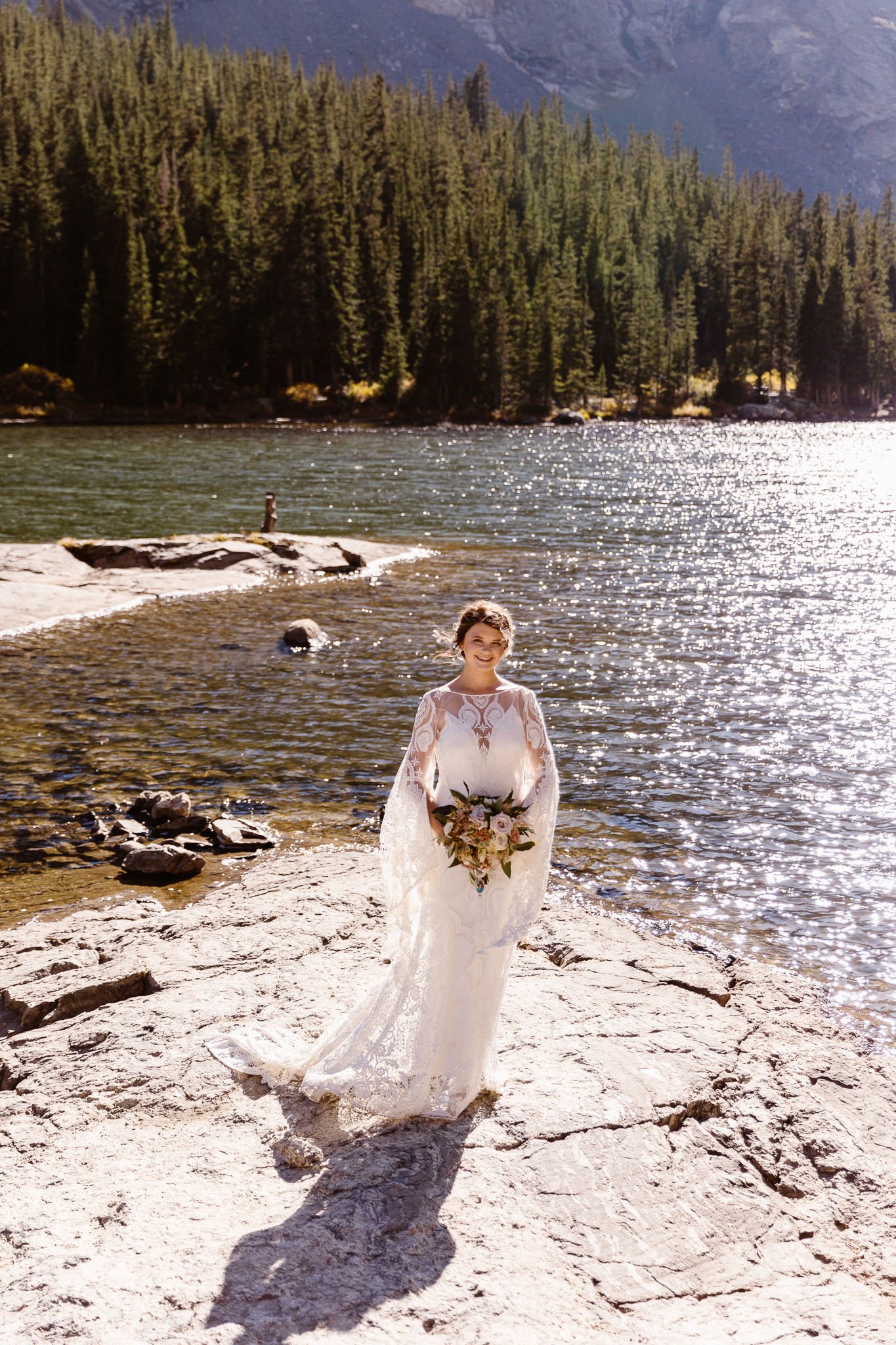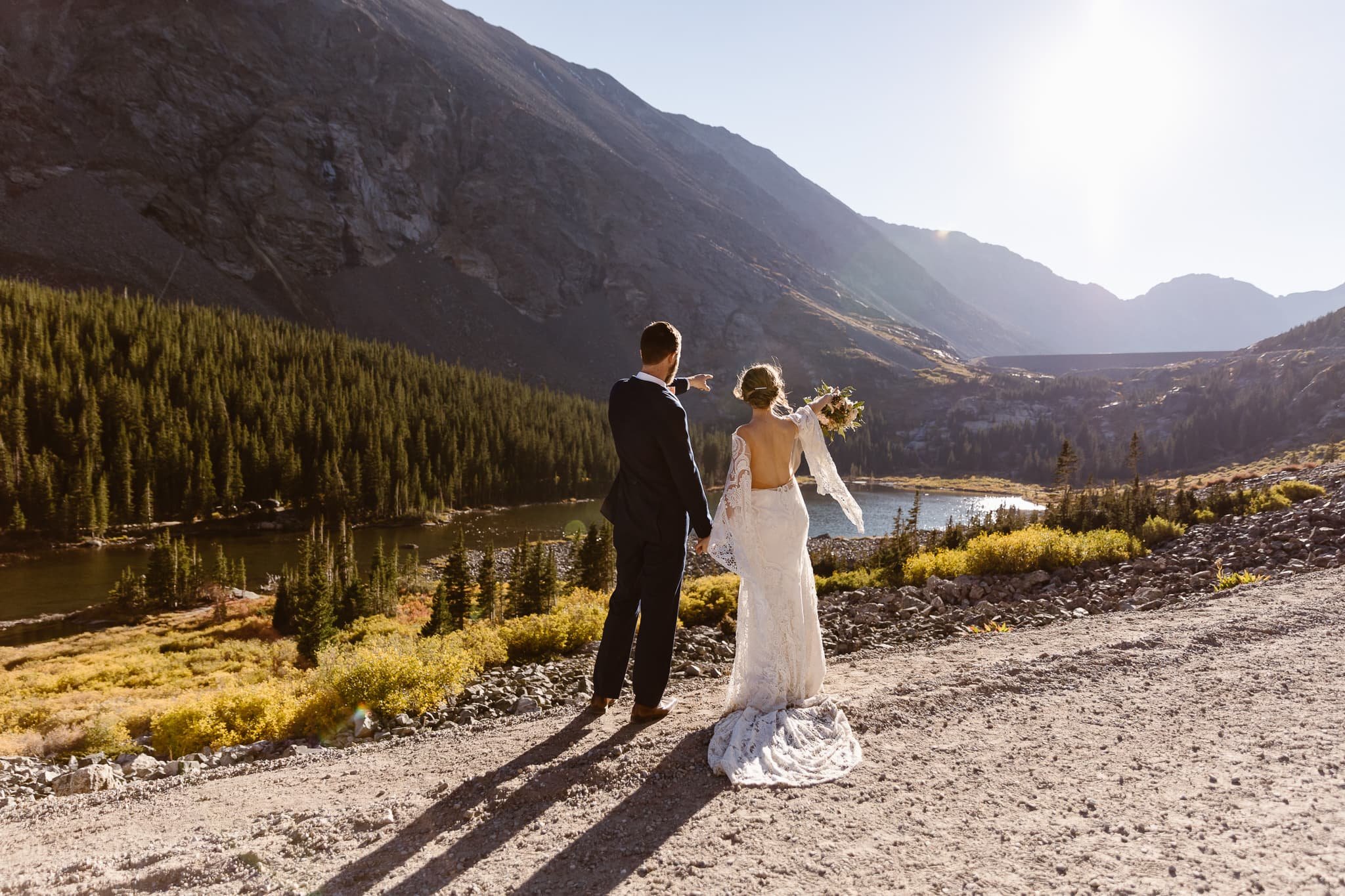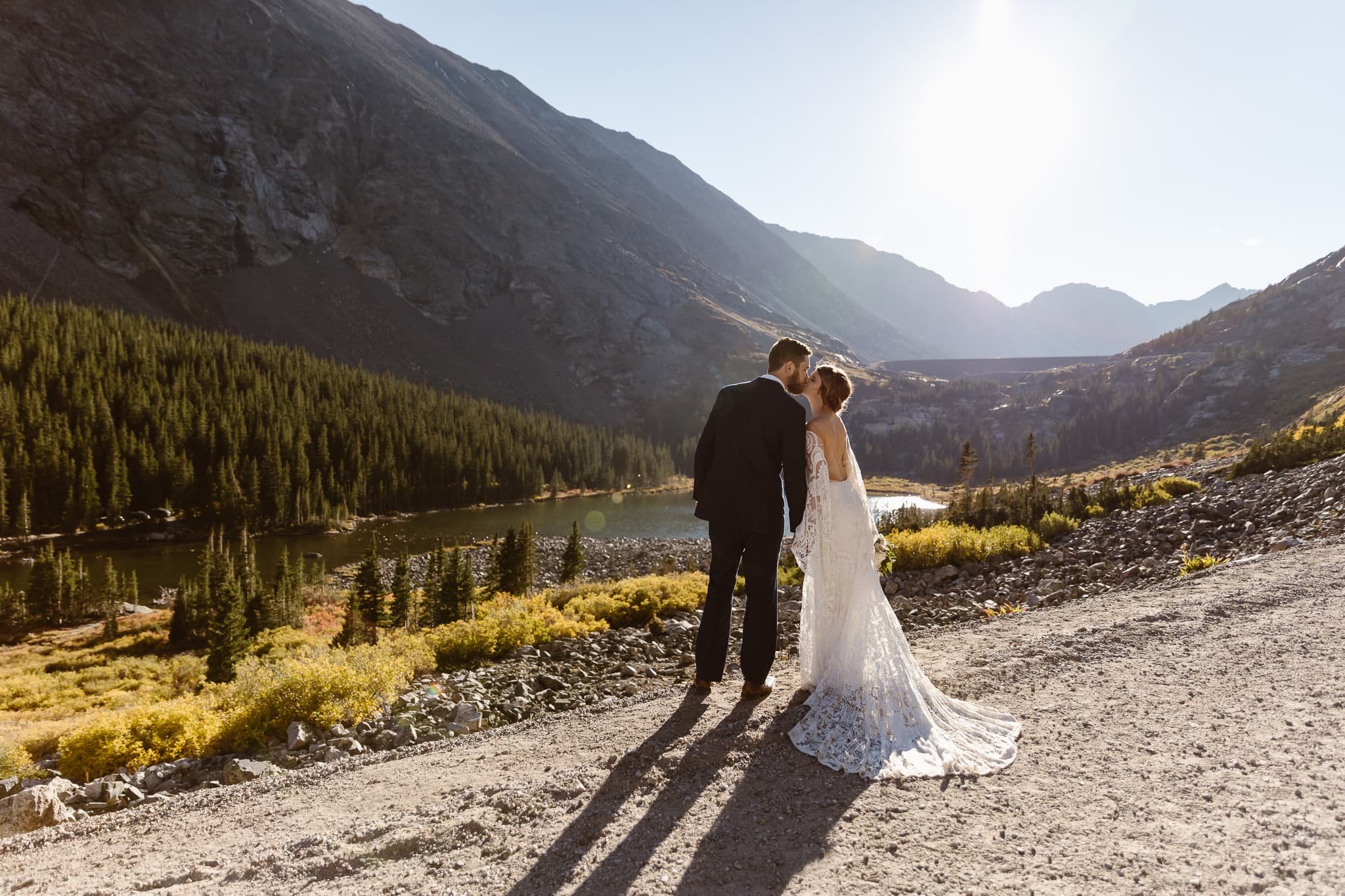Elopement Dress Guide: Choosing a Dress for Your Biggest Adventure
Find the perfect elopement dress that is both beautiful and functional.
Table of Contents
Where to Buy Your Elopement Dress
Budget-friendly
For the mid-range budget
Thrifted (aka eco-friendly)
Local Colorado wedding dresses
Need elopement outfit inspiration? This style guide is for you!
Some things you are 100% sure about. Like the fact that you want to elope in a gorgeous corner of the world. Or that you can’t wait to marry your person in an authentic ceremony that’s true-to-you. If you’re still in the planning phase, some things—like what to wear for your intimate elopement—might be a little less clear. You’re not alone!
The location and time of year that you tie the knot are both critical pieces of the planning puzzle, and the elopement dress that you choose will play an important role in your overall elopement experience. It is crucial that you feel both confident and comfortable so that you can enjoy yourself, your partner, and the day, as well as remember it as a joyous occasion—and not that time you experienced the worst chaffing in your life.
Whether you’re entertaining the idea of an adventurous elopement at 14,000 feet during the peak of summer, or you’re researching an outdoor excursion during our Rocky Mountain winter because you’re already sold on those magical snow-globe vibes, read on, because this guide has you covered!
Elopement Dress Shopping Rule No. 1
The first rule of Elopement Club is there ARE no rules in Elopement Club.
The most important thing is to wear whatEVER you want. Wear whatever you will feel your absolute best in. I am not here to tell you what to wear, but rather to help guide you along your journey to help create one of the most memorable, loving, and happiest days of your life.
Choosing a Wedding Dress for Your Destination + Season
Let’s go back to the example I mentioned earlier. If you are planning on having a hiking adventure elopement in the Rocky Mountains in the middle of February, you might need to rethink that lightweight dress, sheer fabric, and sleeveless look. You would want something with an inner lining if possible, long sleeves, and matching layers like a fur shawl or coat.
The first thing I want you to think about is where and what time of year your dream day will unfold. What would you wear in this setting on a typical day? While I send all my clients location guides, I stress it’s important to do your own research, especially if you have very little or no prior experience in the setting you will be in. April atop Crested Butte’s Scarp Ridge, for example, will look and feel a lot different than the same time of year in Moab’s Canyonlands.
For high elevation adventure elopements, like here in Colorado, here are my expert tips for what the environment is like throughout the year and how best to prepare your attire:
Spring: In the springtime, it is still going to be quite cold, especially at high elevations. Be sure to take that into consideration for how warm your elopement dress will be. You will also want to be sure to be prepared for unpredictable weather like snow, rain, hail, sun, or storms. The biggest thing to keep in mind is how wet this time of year can be. There’s a good chance there’ll be mud on the ground, so if you want to hike but also have a clean elopement dress for your ceremony and photos, it might be best to pack it in. Personally I love a dirty dress! But if you do pack it in, be sure the weight is doable for you or your partner.
Summer: During the summer it’s best to wear something lightweight and flowy to allow for air circulation. You do not want anything too heavy causing you to overexert yourself (or overheat). Long sleeves are not necessarily out of the cards, you’ll just have to make sure they are lightweight or something you can take off. Since the sun is very strong at high altitudes, having sleeves for skin protection is not a bad idea.
Fall: In the early fall such as September, the days can still get warm, while later in the fall (October and November) the days start to cool way down. This shift is escalated when you are at higher altitudes. This is a great time of year to pair your elopement dress with a light shawl or jacket.
Winter: Winter in the mountains is the time for layers and thicker materials. It’s a good idea to have a dress with room for wool undergarments and long underwear. It is also wise to have outerwear such as gloves, hats, fur shawls or coats. This is a great way to pair your elopement dress with fun accessories and for a wider variety of looks!
Talking with your elopement photographer is a great way to learn everything you would need to know about a certain destination. Every environment, elevation, adventure, and season are different so it’s important to do your research.
This information is something I provide for all of my clients! I have you covered completely for your adventure elopement!
If you’re interested in chatting with me about your elopement, please reach out!
How to Adventure With Your Elopement Dress
It is essential to choose the right material, style, and fit for your body and elopement day.
How well does the material feel on you? Is it restrictive without allowing much movement or is it flexible and easy to move around in? If you are planning an adventure elopement it is wise to select a material that moves well with your body.
The same goes for the fit and style of the elopement dress. Dresses that are tight around the hips and restrict your leg movements like a mermaid style are not the most functional when walking long distances on uneven ground and can actually be a bit of a hazard in these settings. Strapless dresses are another style that might be quite uncomfortable walking long distances in.
As I mentioned earlier, you can pack in your dress as well. In my experience, early morning brides prefer to pack in their dresses and hike in hiking clothes, but it’s all up to you and what you want in your photos. Consider avoiding heavier materials like corsets or tulle, or super puffy skirts if you plan to pack in your elopement dress.
Having a train on your elopement dress does create some epic photos—but it’s also something to think about if you are planning on doing much rock-scrambling or rappelling.
Wedding Dresses That Photograph Well
A couple of final things to keep in mind (if it interests you) is to think about how your elopement dress will be complemented by the surrounding landscape. Do you picture your dress coming alive in the wind on top of a towering bluff? Or maybe you prefer a dramatic, long veil that you can take on and off. This way you don’t have to worry about the wind all day, but you can still get a few breezy photos.
The color of your elopement dress is also something to think about. Remember how the fun thing about elopements is that you can do whatever the heck you want? Well, the same goes for the color of your outfit(s)! You don’t have to wear white! If you’re exchanging vows against a snowy scape, white may not even show up that well! You can select a different color that might even be more your style and will really make you pop in photos.
How to Travel With Your Wedding Dress
If you plan on traveling by airplane, the best advice to follow is to absolutely do not pack your wedding attire into a checked suitcase. The worst case scenario—which unfortunately is all too common with flying—is losing luggage. If you can’t live without on your elopement day, pack it in your carry on!
The best way to pack a wedding dress is to keep it in a garment bag to protect it from any spills, rain drops, make up, dirty hands, etc. Gently roll the bag up and place it on top of all other items in your carry on. This will help to lessen wrinkles. It’s always a great idea to pack a portable steamer or call ahead to the place you’re staying (if applicable) and see if they can provide one for you. Your dress and partner’s attire will probably need a touch up once you arrive to your destination.
If you’ll travel by car, this is a bit easier than by airplane. Keep your dress in the garment bag and either hang up or lay over the seats on top of everything else. Do not put anything else on it, as this can cause kinks and wrinkles.
Check out my guide on How to Pack Your Wedding Dress for your Elopement to learn everything you’ll need to know!
Where to Buy Your Elopement Dress
These are some excellent (vetted) suggestions to get you started in your search! If you’re from another state, I recommend looking at your local dress shops, and if you’re from Colorado, let me know because I have tons of local recommendations, depending on where you live.
Budget-Friendly:
Morning Lavender
Azazie
Baltic Born
Reformation
Lulu’s Bridal
Etsy
Mid-Range Budget:
Anthropologie
Nordeen
Jenny Yoo
Kyha Studios
Mywony
Thrifted (& Eco-Friendly!)
Kleinfeld Again
Stillwhite
Loved Twice Bridal
La Laurel
Nearly Newlywed
Rent the Runway
Colorado-Specific:
Runaway Bridal
Little White Dress Bridal Shop
Emma and Grace Bridal Studio
Boulder Bridal
Elopement Wedding Dress Alterations
You have just checked off a major to-do. You have wrapped up what is (for many brides) the most fun part of wedding planning– buying that gorgeous dress. Now it is time to plan out your alterations so that on your big day, you look and feel absolutely picture perfect, in a made-to-measure dress.
Buying Your Wedding Dress and Finding a Tailor
I advise my brides to purchase their dress about 10 months out from the wedding date. Which means, if you’re doing the math, it’s going to be one of the first things you’ll want to start thinking about after you get engaged (assuming your engagement period is around 12-15 months long). Once you have your dream dress in hand, you will want to plan out your fittings and alterations with a trusted tailor. Rely on the experts who sold you the dress (as they oftentimes have in-house seamstresses) or research and find an esteemed tailor who has extensive experience working with wedding attire.
If you live near Denver, here are a few great options for you:
2442 S Downing St, Suite 107, Denver, Colorado 80210
Hours vary
Inspired by the couture techniques of Europe’s premier design houses, Anne uses her 15+ years of experience to meticulously incorporate these advanced sewing methods into each bridal alteration, ensuring a flawless fit and unparalleled craftsmanship. Her commitment to excellence combined with a passion for bridal couture make her the perfect choice for brides seeking the utmost in luxury and elegance.
2000 South Fox Street, Denver, Colorado 80223
Closed Sunday & Monday | Hours vary by day
Founded by Ali Alter in 2020, Artisan Alterations offers expert bridal and garment alterations with a passion for craftsmanship and love stories. Starting in Breckenridge, CO, and later relocating to Denver, Ali, alongside her team member Alex, brings a meticulous eye for detail to every project.
3201 E 2nd Ave, Denver, CO 80206
Open Tues, Wed, Thurs: 8AM - 5:30PM; Fri & Sat: 8AM - 2PM; Closed Sunday
Donna has worked on hundreds of designers in all price ranges, fabrics, and styles. With 30 years of expertise, her team alters gowns for weddings, special events, bridesmaids, mother-of-the-bride, and special events.
9635 W Colfax Ave suite 2D Lakewood, CO 80215
Closed Sunday & Monday | Hours vary by day
Gabriela is an award-winning fashion designer with more than 20 years of experience in wedding gowns, evening wear, and special occasions, plus expert restyling of vintage wedding gowns. Her shop is not simply a place to design, sew, or alter a garment, it is where a piece of fabric becomes something beautiful and amazing.
6520 Wadsworth Blvd #209B Arvada, CO 80003
Closed Monday | Hours vary by day
As the leading alterations specialists in Arvada, The Wedding Seamstress takes in their affordability, passion, and timeliness. Their equipment is set up only to work with delicate fabrics associated with bridal wear and it shows with each and every dress that leaves the studio. I love their emphasis that “every woman deserves to feel beautiful”.
How Many Fittings a Bride Will Need
Typically, a bride will need to attend three fittings. Do your first fitting 8-12 weeks out from the wedding date, and schedule your last for a mere 1-2 weeks out. If you are planning to do any major changes to your dress (upcycling a vintage silhouette or adding beading to the entire bodice), of course, you will need to allot more time to this process.
Types of Alterations
There are three overarching types of alterations that you might consider as you work to perfectly customize your wedding dress. They are a) hemming; b) taking the dress in or out; and c) adding custom details. Your expert seamstress can guide you in making just the right choices for you and your figure. When you hem a wedding dress, the rule of thumb is typically to allow it to just graze the ground. However, it is imperative that you also consider any activity that you might be doing on your wedding day. Most of my clients hike or climb or even snowshoe, so factor that in as you alter your dress. Your tailor will know where to take in, and/or where to let out, your dress. I suggest that you move around during your fittings– sit, jump, dance, hug, lean over… Do all the things you will likely do on the day of your wedding. Notice any tweaks you might need to make. If you are constantly pulling up your sweetheart neckline, more work needs to be done! If your straps fall everytime you dance, more work needs to be done. You want your dress to flawlessly compliment and accentuate your figure, and at the same time be effortlessly comfortable. Lastly, you may choose to add custom details to your dress. These include, but are not limited to: straps, sleeves, trains, bustles, beads, buttons… I recently worked with a bride who had her new initials monogrammed underneath her dress in a charming “something blue” color. These details– which photograph beautifully– can take time, so plan accordingly.
What to Bring to Every Fitting
It is of utmost importance that you bring, to each and every fitting, the exact undergarments you plan to wear under your dress, and your shoes. Your seamstress needs to delicately fine-tune her pinning and sewing around the exact measurements of your body, so make sure to find those perfect little underthings that smooth you out and allow you to dance and move and breathe freely (bras, underwear, shapewear, etc) and bring them to every appointment. Also, in order for your tailor to gauge the perfect height for the hem of your dress, he or she will need to see you in the shoes you plan to wear on the big day. (For many of the brides I work with, we are talking hiking boots!) Finally, although it’s not mandatory, try to bring along a trusted friend or family member. They can provide an extra set of eyes, provide good advice, cheer you on, and maybe share some champagne with you!
All in all, you want to dedicate the right amount of time and effort to polishing and perfecting your dress so that you will feel and look your absolute best on this most important and happiest of days.
Once you have found the perfect dress that you will feel your absolute best in, take a look at my Elopement Guidebook for all of the details you need to plan your adventure elopement!
As an elopement photographer and a lover of all outdoor adventure, I am here as a resource for you every step of the way; from the beginning stages of daydreaming to the gallery delivery and beyond—I am here for it all!
If you are interested in an elopement photographer who is also your dedicated partner in the elopement planning process, please reach out—I’d love to connect and help plan your dream day!
Ready to Book?
If you’re ready to get the ball rolling to secure your photographer (slash wedding planner!) that’s great!
You can do that by contacting me through my website, emailing me directly at andreaenger.photography@gmail.com, or by calling or texting me at (720) 739-0784. I look forward to hearing from you!
If you’re still in the research phase, I hear ya! Here are some more resources that my couples have found helpful. I hope you do, too!

